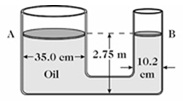Assignment:
Problem 1
(a) What is the heat needed to bring 12.0 g ice from -17.0°C to 0°C ice? (The specific heat of ice is 2.00 kJ/kg °C.)
(b) What is the heat needed to change 12.0 g ice at 0 °C to 0°C water? (For water the normal melting point is 0°C and the heat of fusion is 334 kJ/kg.)
(c) What is the heat needed to bring 12.0 g water from 0 °C to 25.0°C? (The specific heat of liquid water is 4.19 kJ/kg °C.)
(d) If the density of ice is 0.917 g/cm3 , what is the volume of 12.0 g ice? When ice is changed to water, will the volume increase or decrease? (The density of water is 1.00 g/cm3.)
(e) The 12.0 g water at 25.0 °C is now mixed with 35.0 grams of water that is initially at a temperature of 167°F. Assume that no heat is lost to the surroundings and that the container has negligible mass. What is the final temperature of the water mixture after it reaches the thermal equilibrium?
Problem 2
If a spring-mass system makes 12 complete up-and-down cycles with amplitude of 0.50 meters in 8.0 s,
(a) What is its frequency?
(b) What is its period?
(c) What is the spring constant k of the spring if the mass of the system is 0.25 kg?
(d) What is the total potential energy of the system?
(e) What is the maximum speed of the mass? Where the system has its maximum speed?
Problem 3
A container consists of two vertical cylindrical columns of different diameter connected by a narrow horizontal section, as shown in the figure. The open faces of the two columns are closed by very light plates that can move up and down without friction. The tube diameter at A is 35.0 cm and at B it is 10.2 cm. This container is filled with oil of density 0.820 g/cm3. Initially both plates are leveled at 2.75 m from the bottom (see the figure below).
(a) If a 125 N force is placed on the larger plate at A, how large is the force provided by the smaller plate at B?
(b) If the column A decreases its height by 0.250 m, how high the column B will be? (Assume the column B has a tube which is high enough to contain its liquid.)
(c) What is the work done with the column A for the 125 N force moved a distance of 0.250 m?
(d) What is the work done with the column B?
(e) Comment on your results of (c) and (d). Does energy conserve here?

Problem 4
Two police cars have identical sirens that produce sound of frequency of 572 Hz. A stationary listener is standing between two cars. One car is parked and the other is approaching the listener and both have their sirens on.
(a) What is the wavelength of this wave if the speed of sound in air is 343 m/s?
(b) Is this a longitudinal wave or transverse wave?
(c) If the sound intensity is 2.17 x10-6 W/m2 at the listener's location, what is the intensity level in dB? The threshold of human hearing is 1.00x10-12 W/m2.
(d) What is the frequency of the siren from the police car that is approaching you at a speed of 15.0 mph?
(e) What are the beats per second the listener hears?